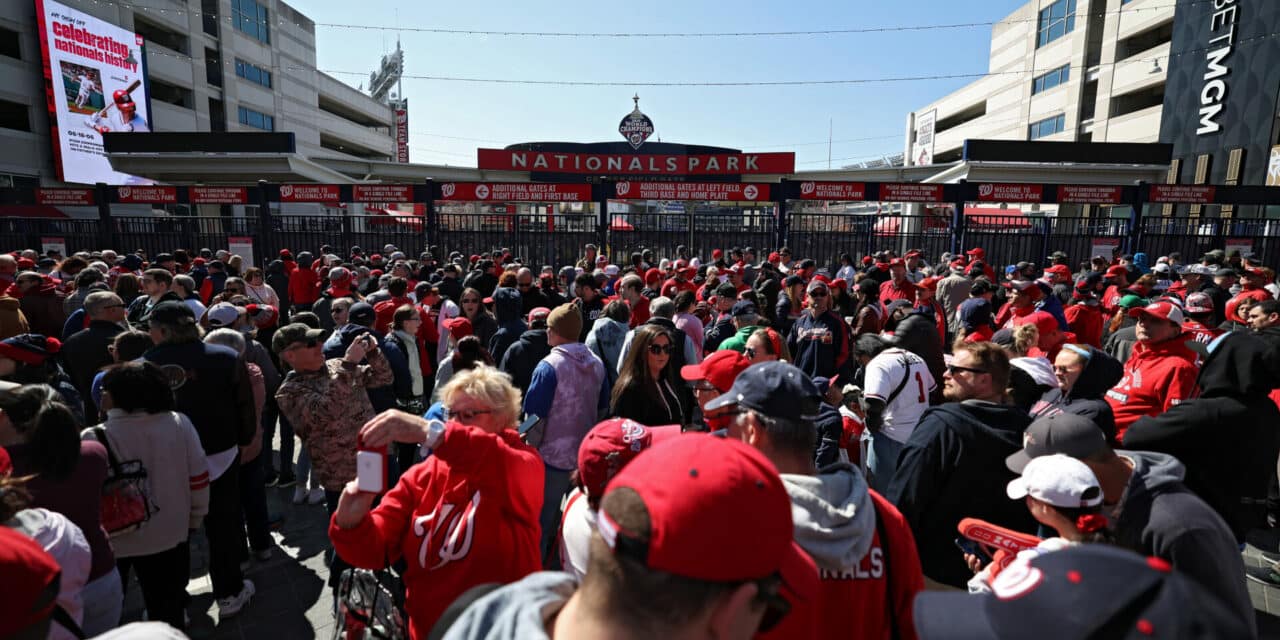TECH-SAVVY: NTT Data will deploy its Smart Venue Technology system at Nationals Park that uses artificial intelligence to assess crowd numbers in specific areas and helps stadium staff make better decisions. (Getty Images)
AI SYSTEM TO IMPROVE CROWD FLOW
The Washington Nationals front office has yet to make a splash to improve the team as the Aug. 1 trade deadline nears, but the organization has struck a tech deal that will enhance the fan experience at the ballpark.
Lerner Sports Group, which owns the Major League Baseball team, recently announced a partnership with NTT Data, a global information technology and communications company headquartered in Japan, that will officially bring the tech business’s advanced data analytics software to Nationals Park. NTT would not discuss the financial details of the agreement.
The service known as Smart Venue Technology, or SVT, uses software that analyzes data from optical sensors placed throughout the stadium and devices connected to the internet such as cameras and ticket scanners. The system then provides stadium operators with information that helps them manage staff and crowds in certain areas at specific times. Though NTT did not divulge the cost of their services, a spokesperson said the pricing is tailored to the environment.

MOTION MAN: Christopher Merdon, NTT Data Services group president, public sector, said his company’s analytics software can help Nationals Park staff “better understand their fan movement throughout the stadium.” (Courtesy NTT)
“This isn’t a revenue-generating opportunity for them in any way,” said Christopher Merdon, NTT’s group president, public sector. “They want to make sure that families enjoy coming into the ballpark and their experience is a positive one. They can enhance that experience using technology to analyze where fans are congregating to get concessions and help them make better decisions on staff placement, replenish food at the stand and understand what the peak times are. Our analytics really help them better understand their fan movement throughout the stadium.”
See: Indy 500 Tech Predicts Future Of Racing
To process the data, SVT relies on artificial intelligence to make sense of it and deliver the information in a way that is easy to understand for the client. AI has been a widely discussed issue in various industries — especially music, film and television — with many expressing reservations about the technology. To address concerns about privacy issues, Merdon assures that the system doesn’t collect data from any individual, nor does it perform facial recognition. It only scans a crowd to determine the number of people to help stadium staff make informed decisions.
Crowd intelligence is an evolving technology that more sports teams and entertainment venues are investing in. WaitTime offers a similar service to clients such as T-Mobile Arena, the Denver Broncos and the Los Angeles Dodgers, assisting them in determining popular areas among fans and reducing the amount of time one waits in line for ticketing and concessions.
NTT has been a sponsor for the Nationals with on-field advertising along the first and third base lines, so it was only natural for the two parties to start talking about how they can help each other with a practical application. The Nationals dipped their toes into NTT’s services with a pilot program of the new technology in May, and the new deal between the team and the Japanese company extends their working relationship through the end of the year. Though the team is utilizing SVT with concessions in mind, Merdon said the system in place puts them on a road map to expand their services should the Nationals request it.
“With most of our clients, we like to crawl before we walk,” said Merdon. “It takes time for our partners to fully understand the depth and breadth of what is available to them and map out their priorities. Our hope is that as we mature our relationship with the Nationals, we’ll be able to take that data analytics to the next level for the individual fan experience like we’ve done with the Indy 500.”
As an official sponsor of the motorsports event that draws 150,000 spectators, NTT’s analytics not only sought to improve crowd movement but also provided fans with racing analysis and up-to-date predictions on their smartphones.
“Fans could use the app on their phone to enhance their experience by looking at data,” Merdon said. “We had about 140 sensors on each car that could look at tire wear, the G-force on the driver, what happens when the driver brakes and then interpret that and make some predictions on who’s going to win the race based on those different points of data. We’re hopeful that our journey with the Nationals will take them to that next level of fan experience where they can look at their phone and have another dimension to watching the game.”

SPONSORSHIP TO PARTNERSHIP: NTT Data, painted near the first and third base lines at Nationals Park, has also worked with Indianapolis Motor Speedway and Little Caesars Arena in Detroit, Michigan. (Getty Images)
SVT was initially designed with public safety in mind years ago when NTT began working closely with the city of Las Vegas following the 2017 shooting in which a lone gunman opened fire at a crowd attending a music festival and killed 60 people. The smart platform was developed to be a “force multiplier” for the local police department and help law enforcement focus on the city’s more critical needs.
“Our company tried to figure out how we could help the city prevent an incident like this from happening again in the future, but also how do we help make lives better for its residents and millions of visitors that visit Las Vegas everywhere?” Merdon said.
NTT quickly realized that its analytics software was applicable in other areas of sports and entertainment, and the company began working with venues such as Indianapolis Motor Speedway and Detroit’s Little Caesars Arena. The tech company didn’t rule out expanding its services to other venues and event organizers, but it is focused on working with New York City to implement a system that assists teachers and police during active shooting incidents.
“The next step will be working with education systems to help with campus security,” Merdon said. “A lot of schools and universities have [internet of things] devices throughout the school and the university such as cameras. The platform has this great technology already, and we’re just looking for other venues for us to implement it. I believe that education will be the next way that we leverage the platform to provide school safety.”







